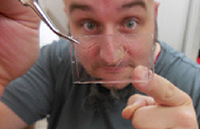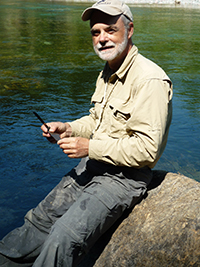 Viktor A. Baranov. Ludwig-Maximilians-Universität München, Biocenter, Planegg, Bayern, Germany. Correspondence author. baranow@biologie.uni-muenchen.de
Viktor A. Baranov. Ludwig-Maximilians-Universität München, Biocenter, Planegg, Bayern, Germany. Correspondence author. baranow@biologie.uni-muenchen.de
Viktor Baranov studied biology (BSc) and zoology & animal ecology (MSc, honors) at the V.N. Karazin Kharkiv National University (Ukraine). After completion of the Master degree in 2011, he worked for two years as a adjunct at the department of zoology of his alma mater, teaching medical zoology and parasitology. Between 2011 and 2013 he visited number of the international labs, including entomological laboratory of the Bergen University Museum (Norway), Gdansk laboratory of the amber Palaeobiology(Poland) and Zoological Institute in St. Petersburg (Russia). In 2014 Viktor Baranov has won Marie Curie early career fellowship, which allowed him to pursue phd in the ecology and biogeochemical impact of the aquatic insects on the carbon and oxygen cycles in lakes. After receiving his phd in Environmental and Earth science (2017) from Humboldt University of Berlin, he proceeded for a 1.5 year postdoc in the department of River Ecology and Conservation of Senckenberg Museum (Gelnhausen), working on long term trends in aquatic insect communities. Since October 2018 he works in the Joachim Haug’s research group (LMU Munich), dealing with evolutionary biology and ecology of the Holometabolan insects larvae. Life long interest, and encompassing framework of the Viktor Baranov’s studies is biology and geological history of aquatic Diptera, predominantly Chironomidae.
![]()
 Joachim T. Haug. Ludwig-Maximilians-Universität München, Biocenter, Planegg, Bayern, Germany and Geobio-Center, Ludwig-Maximilians-Universität München, München, Bayern, Germany. jhaug@biologie.uni-muenchen.de
Joachim T. Haug. Ludwig-Maximilians-Universität München, Biocenter, Planegg, Bayern, Germany and Geobio-Center, Ludwig-Maximilians-Universität München, München, Bayern, Germany. jhaug@biologie.uni-muenchen.de
Joachim T. Haug studied animal ecology (major), sociobiology and palaeontology (minors) at the Julius-Maximilians-Universität Würzburg. After the receipt of the Diplom in 2005, he moved to the work group Biosystematic Documentation at the University of Ulm for his PhD thesis. There he worked on the early crustaceans from the Cambrian 'Orsten', which are preserved three-dimensionally and with minute details. To make the entire morphology clearly visible, Joachim produced computer-based 3D models for each developmental stage of a species, resulting in a 4D model of the species. With 4D models reconstructed for the different species, differences in the developmental pattern between the species became visible. These changes in the developmental timing, so-called heterochronic events must have occurred several times during early crustacean evolution. Due to these findings, Joachim got interested in studying such evolutionary changes of development also in fossils from other deposits and focussed on Palaeo-Evo-Devo (see also http://www.palaeo-evo-devo.info). After his defense in 2009 and two further years as postdoctoral researcher in Ulm, he received two Feodor Lynen research fellowships from the Alexander von Humboldt-Foundation, with which he was doing research at Yale University and at the Ernst-Moritz-Arndt-Universität Greifswald. Besides 3D modelling, Joachim is also interested in different methods of imaging (documentation and presentation). In September 2013, he relocated to the Ludwig-Maximilians-Universität in Munich. In April 2018 Joachim became a Lichtenberg professor at the Ludwig-Maximilians-Universität München (LMU Munich) funded by the Volkswagen Foundation.
![]()
 Dale E. Greenwalt. Department of Paleobiology, National Museum of Natural History MRC 121, Smithsonian Institution, 10th & Constitution Ave. NW, Washington, D.C., United States. 20013-7012, USA. GreenwaltD@si.edu
Dale E. Greenwalt. Department of Paleobiology, National Museum of Natural History MRC 121, Smithsonian Institution, 10th & Constitution Ave. NW, Washington, D.C., United States. 20013-7012, USA. GreenwaltD@si.edu
Dale Greenwalt received his BA from the University of Minnesota, an MSc from Bemidji State University and his PhD from Iowa State University. He was an Assistant Professor of Biochemistry at San Jose State University before moving to the biotechnology industry, working at Human Genome Sciences and Poietic Technologies, the latter at which he was Director of Research. He is currently a Research Collaborator at the Smithsonian’s National Museum of Natural History where he is establishing a collection of fossil insects from the Eocene Kishenehn Formation in northwestern Montana.
![]()
 Ralph Harbach. Department of Life Sciences, Natural History Museum, Cromwell Road, London SW7 5BD, United Kingdom, R.Harbach@nhm.ac.uk
Ralph Harbach. Department of Life Sciences, Natural History Museum, Cromwell Road, London SW7 5BD, United Kingdom, R.Harbach@nhm.ac.uk
Ralph Harbach is a taxonomic and systematics research and medical entomological studies on mosquitoes (Culicidae). Most of his research focuses on the morphology, taxonomy, phylogeny and classification of mosquitoes, with an aim to document their diversity and establish a natural and testable classification that can be used as a foundation for more detailed studies of their biology and medical importance.

